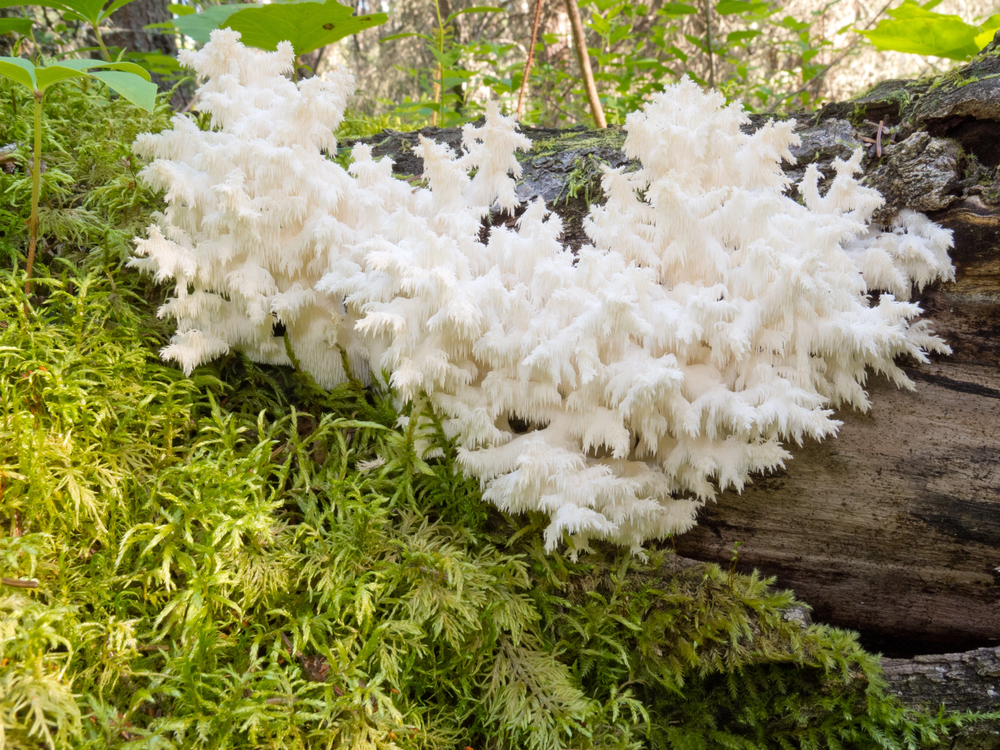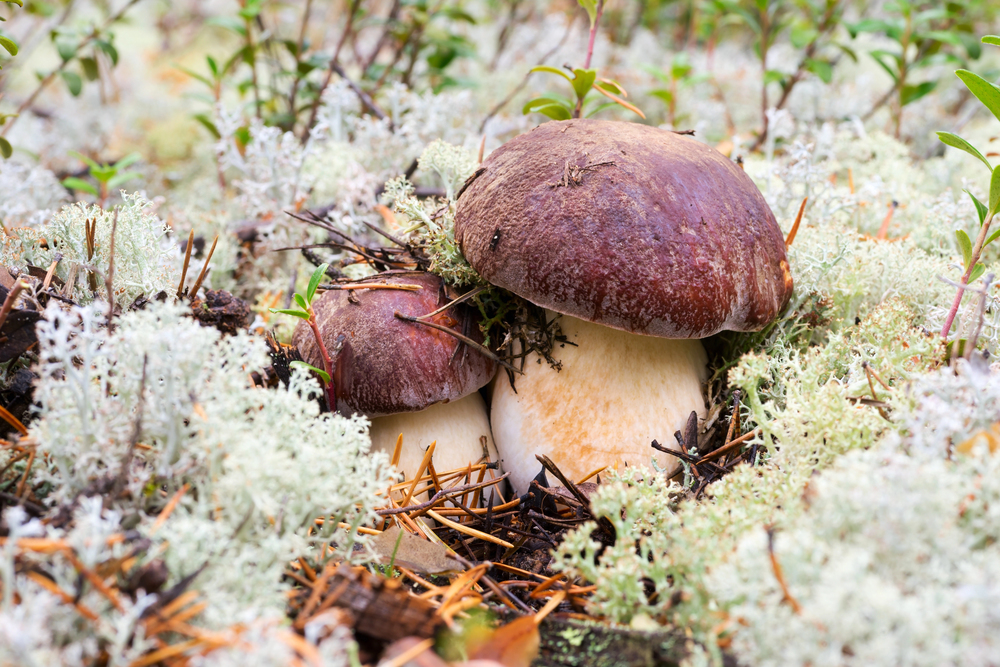The world of Chanterelle mushrooms is diverse and captivating, with each species offering unique characteristics and flavors.
From the golden Yellow Chanterelle with its fruity aroma to the earthy Black Trumpet Chanterelle with its rich, nutty taste, these fungi have captured the attention of chefs and foragers.
Beyond these well-known varieties, there are numerous other Chanterelle species waiting to be discovered, each adding depth and complexity to the culinary world of mushrooms.
Chanterelle Mushroom Overview
The Chanterelle mushroom, known for its apricot aroma and delicate flavor, is prized in culinary circles for its unique characteristics. This species, classified under the genus cantharellus, has funnel-shaped caps in yellow, orange, or brown hues.
Chanterelles have a meaty texture ideal for cooking, making them popular in various dishes. Found in forests in Europe and North America, chanterelles grow in symbiosis with trees and require expertise to harvest safely. Due to high demand and seasonal availability, they are often foraged or cultivated through specialized farming.
Celebrated for their versatility, chanterelles enhance dishes with their earthy, fruity notes, elevating soups, sauces, and sautés with elegance and depth.
Native Regions of Various Chanterelle Mushroom Species
| Chanterelle Mushroom Species | Native Region(s) |
|---|---|
| Yellow Chanterelle (Cantharellus cibarius) | Europe, North America |
| Black Trumpet Chanterelle | Europe, North America, Asia |
| Pink Chanterelle | Europe, Asia |
| Purple Chanterelle | Europe |
| Red Chanterelle | North America |
| White Chanterelle | Europe, North America |
Golden / Yellow Chanterelle (Cantharellus cibarius) Characteristics
The Yellow Chanterelle, scientifically known as Cantharellus cibarius, is prized for its vibrant golden hue, fruity aroma, and versatile culinary applications. It has a funnel-shaped cap with wavy edges, vibrant yellow color, and gill-like ridges on the underside.
This mushroom has a meaty texture that holds up well when cooked, adding chewiness to dishes and absorbing flavors. Its flavor profile is delicate and nutty, with hints of apricot or peach that intensify when cooked, enhancing the depth of various dishes.
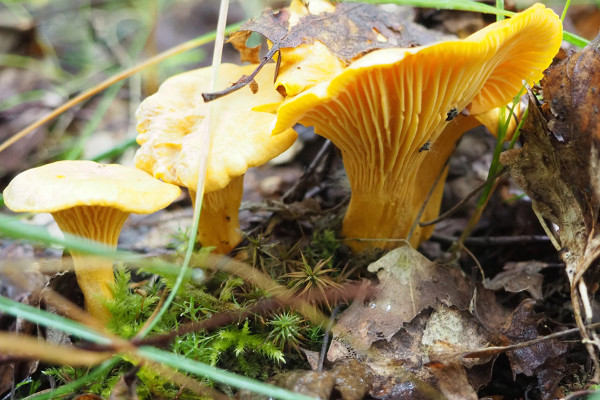
Black Trumpet Chanterelle Species (Craterellus cornucopioides)
Black Trumpet Chanterelle mushrooms are prized for their distinct flavor and culinary flexibility, making them highly desirable in gourmet cooking. With a rich, earthy taste that enhances a variety of dishes, their elegant trumpet-shaped appearance also adds sophistication to plated creations.
Chefs admire the Black Trumpet Chanterelle for its capacity to enhance the overall dining experience.
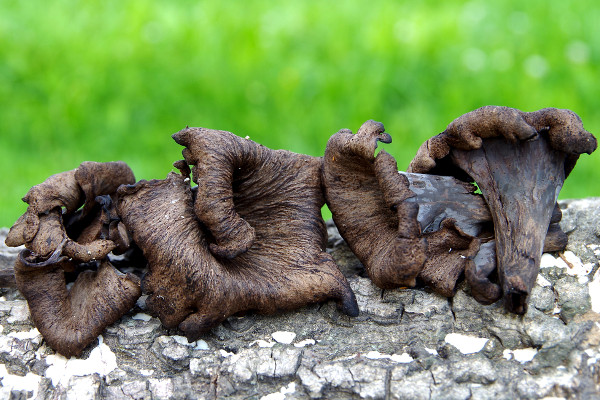
Unique Taste Profile
Highly prized for its unique flavor profile, the Black Trumpet Chanterelle stands out in the world of gourmet cooking.
It offers an earthy, rich, and nutty taste with subtle hints of fruitiness.
When cooked, these mushrooms develop a deep umami flavor that enhances any dish, making them a sought-after ingredient for chefs and food enthusiasts.
Culinary Versatility
Black Trumpet Chanterelle mushrooms are prized for their adaptability in various culinary applications. With a unique earthy flavor and subtle hints of fruitiness, they are a favorite choice among chefs for enhancing dishes.
Whether sautéed, roasted, dried, or used in soups and sauces, Black Trumpet Chanterelles add depth to a wide range of dishes including stir-fries, risottos, pizza toppings, vegetable medleys, seasonings, rubs, creamy soups, and pasta sauces.
White Chanterelle Identification (Cantharellus subalbidus)
White Chanterelles can be distinguished by their distinct color and cap shape compared to other varieties.
Knowledge of their specific habitat preferences is important for accurate identification in the wild.
Unique Color Features
White chanterelle mushrooms can be identified by their pale ivory to creamy white color with hints of yellow or pink, distinguishing them from other species.
The color of white chanterelles may vary based on factors like age, habitat, and environmental conditions.
Cap Shape Variations
White chanterelle mushrooms can be identified by their convex caps with smooth and wavy edges. The cap shape varies from flat with a depressed center to slightly funnel-shaped, and some may have irregular or wavy margins.
These differences in cap shape are key for distinguishing white chanterelles from other mushrooms and are essential for accurate identification while foraging.
Understanding the nuances of cap shape variations is essential for successfully recognizing and enjoying these sought-after mushrooms.
Growing Habitat Preferences
White chanterelle mushrooms, especially the white variety, have specific growing preferences that are key to their identification. They are commonly found in mixed forests with a mix of coniferous and deciduous trees, thriving in well-drained soil rich in organic matter.
They prefer acidic to slightly alkaline conditions and thrive in humid environments, appearing after rainy periods in late summer to early fall.
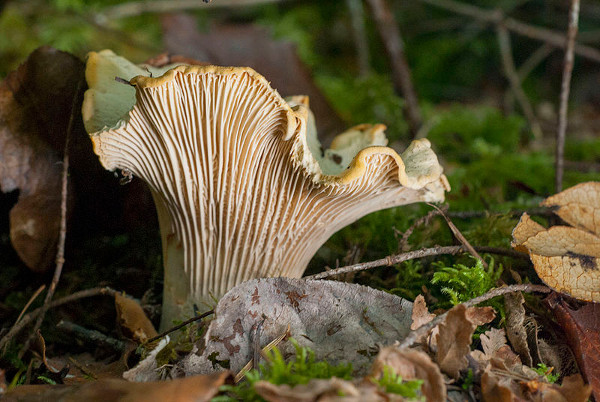
Red Chanterelle Varieties (Cantharellus cinnabarinus)
Red chanterelle mushrooms come in various types, each with distinct characteristics and flavors. Cantharellus cinnabarinus is known for its vibrant red color and fruity aroma, found in North America and Europe.
Cantharellus roseocanus has a deeper red hue and peppery taste, often found in coniferous forests in Asia and parts of North America.
Cantharellus rubescens, with its reddish-brown cap and nutty flavor, is commonly found in mixed woodlands in North America and Europe.
These sought-after mushrooms should be properly identified to avoid any potential risks, as some red mushrooms can be toxic.
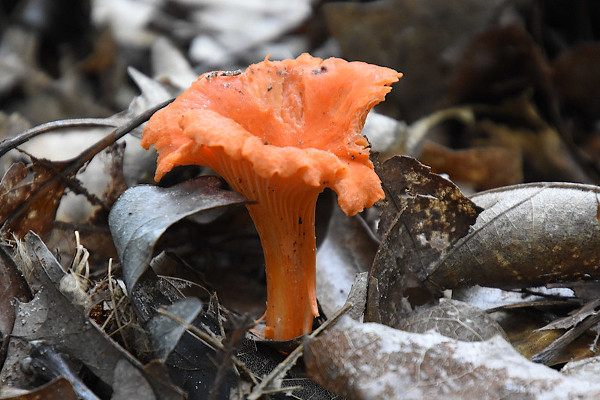
Blue, Purple or Black Chanterelle Features (Polyozellus)
Blue Chanterelle mushrooms are renowned for their rare blue color, which distinguishes them from other varieties.
They offer a unique flavor profile that can enhance culinary dishes, making them a sought-after ingredient for those who appreciate their distinctiveness and taste.
Unique Blue Color
The unique blue color of the Blue Chanterelle mushroom is rarely seen in nature, captivating researchers and foragers alike. Its vibrant blue cap with subtle shade variations, distinctive blue gills, and blue-tinted stem make it easily distinguishable.
This rare coloration adds to the mushroom’s allure in culinary and scientific circles.
Distinctive Flavor Profile
The Blue Chanterelle mushroom is known for its rich, earthy flavor with subtle fruity hints, making it a unique culinary delight. Its delicate and complex taste sets it apart from other chanterelle varieties.
The blue hue of the mushroom indicates its savory yet slightly sweet flavor profile. When cooked, the Blue Chanterelle maintains its robust taste, making it a prized ingredient in gourmet cooking.
Chefs and food enthusiasts appreciate its ability to enhance dishes with exceptional taste and aroma.
Purple Chanterelle Facts
Purple chanterelles, scientifically known as Cantharellus cibarius var. Amethysteus, stand out with their vibrant purple caps and yellowish-orange stems. These mushrooms have a rich, earthy flavor with subtle peppery notes, making them popular among foragers and chefs.
They are typically found in coniferous forests with acidic soils and cool, damp climates, growing under pine, spruce, and fir trees. Purple chanterelles are not as common as golden chanterelles, adding to their appeal for mushroom enthusiasts.
Besides their unique appearance and taste, these fungi are nutrient-rich, containing essential vitamins, minerals, and antioxidants. Research suggests they may have anti-inflammatory and immune-boosting properties, making them a valuable ingredient for health and wellness.
Pink Chanterelle Types
Pink chanterelles are native to North America, particularly in regions such as the Pacific Northwest and the Appalachian Mountains. They can also be found in parts of Europe and Asia.
Pink chanterelles are known for their delicate blush pink color and unique fruity flavor with subtle peppery notes.
Their velvety and tender texture adds a pleasant mouthfeel to dishes, making them versatile for a variety of recipes like creamy pastas and savory sauces.


